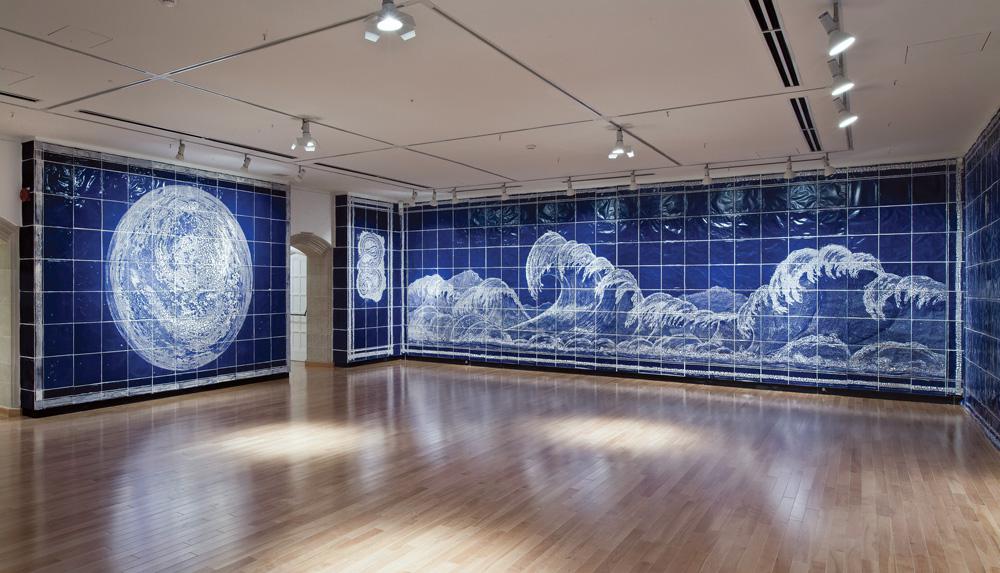This summer, Douglas Walker’s adaptable travelling installation Other Worlds (2011) swept in from Halifax to submerge the Justina M. Barnicke Gallery in a sea of blue and white. Running from floor to ceiling around the gallery, panels of painted paper tiled the walls to produce an immersive, oceanic experience.
Walker strikes a delicate balance between figuration and abstraction, in pursuit of engaging the subconscious. He removes himself slightly from the process of authoring, to stream his pictorial elements as if they formed themselves, like rivulets of information. The grid format establishes a stability that contrasts with the swirling forms.
Archetypal imagery flows across the walls. Waves break, but the forms also make cultural reference to Katsushika Hokusai’s waves. The blue and white–tiled craquelure effect evokes Dutch ceramic culture from Delft. A huge, white moon alludes to universal lunar fascination, a gigantic whale—a powerful mythological symbol of maritime monsterhood—is shown traversing the ocean currents of the world, and vast suspension bridges connect Eastern, perhaps Chinese, towers amid whorling clouds and forest vistas.
Walker refers to worlds beyond geographical understanding, too. A large, delineated mask of a face stares impassively as rhythmic lines describe the planes and muscles or pass within the skull. A blue body lies stretched out in silhouette, surrounded by a white mist, evoking perhaps religious ideas of death and spiritual journey. A propensity for language and signs seeps through forms that hover ambivalently between image and associative streams of text. The brushstrokes take on the look of biological vegetation, as if “growing” the text into communication.
Walker’s methodology for creating the works is equally intricate. He uses a resist procedure that capitalizes on the lack of miscibility in oil and water. The creative act takes place within a state of fluidity and the artist sets the process in motion working from above, wet on wet. Oil dries by oxidation whereas water dries by evaporation, which means differing time intervals and the generation of unusual stresses on the paint films. The element of chance shapes the emerging imagery, and Walker meanders with the flow.
His paintings bring to mind the French symbolist Gustave Moreau, who created hallucinatory architectural structures that tapped into the Gothic sublime and created a sense of awe before the void (paradoxically also a leitmotif for Harold Rosenberg’s existential assessment of abstract expressionism). Walker delves into visual incident like a surrealist Automatiste, but emerges as a unique visionary. He is at once meticulous and deferential, like a mariner navigating uncertainty to allow free passage of the universal subconscious.
This is a review from the Fall 2012 issue of Canadian Art. To read more from this issue, please visit its table of contents.

 Douglas Walker (left) A-789 and (right) A-784 2011 / photo Toni Hafkenscheid
Douglas Walker (left) A-789 and (right) A-784 2011 / photo Toni Hafkenscheid







